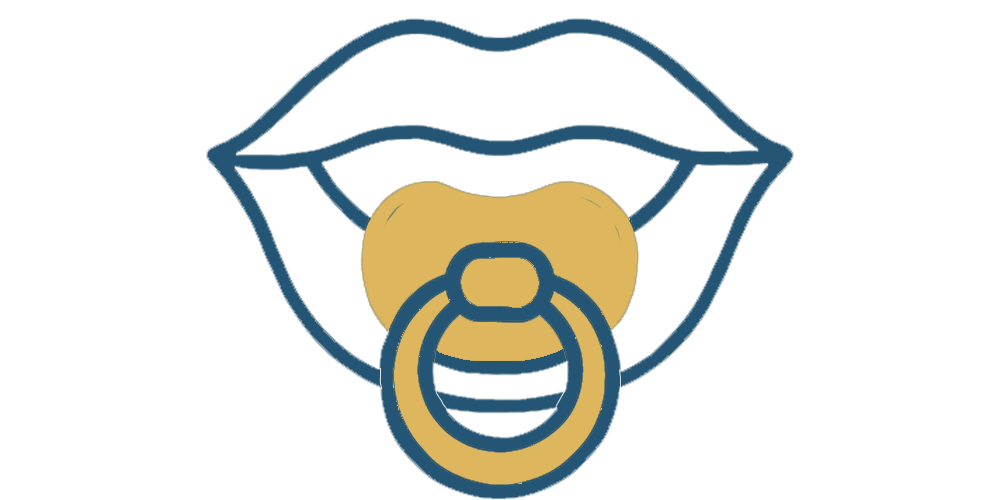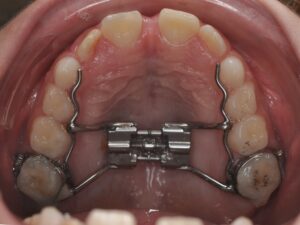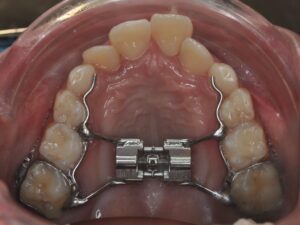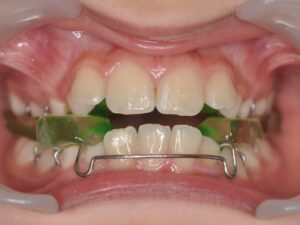INTERCEPTIVE ORTHODONTICS
Early Childhood Orthodontics

This type of orthodontics is for young children. It aims to intercept growth or eruption issues that could become irreversible if not addressed early.
In general, there are three main areas of focus.
-
THE ORTHOPEDIC AXIS
This focuses on redirecting the growth of the upper and lower jaws.
As long as the child is still growing, jaw development can be unlocked or guided to promote harmonious growth. -
THE DENTAL AXIS
This involves maintaining or reopening spaces to allow permanent teeth to erupt properly.
Baby teeth are often underestimated, yet they play a key role in the eruption of adult teeth. It’s important to understand that nature dislikes empty spaces—premature loss of a baby tooth can lead to insufficient room for the adult tooth to come in. It may therefore be necessary to maintain or reopen certain spaces.
-
THE FUNCTIONAL AXIS
This includes chewing, breathing, tongue posture, and harmful habits. These functions are integral to the correct alignment of jaws and teeth, and will also be monitored and corrected.
A variety of appliances may be used depending on the type of malocclusion—they can be either fixed or removable.
Interceptive treatment is often combined with visits to other specialists such as an ENT, speech therapist, physiotherapist, or osteopath.








FAQ
On average, interceptive treatment lasts about one year.
Consistent and diligent use of the appliance is essential for the treatment to be effective.
It’s recommended to schedule a consultation around the age of 7 to avoid missing the optimal treatment window.
Interceptive treatment should begin before the growth spurt, which varies from child to child.
⚠️ Note: The growth spurt occurs earlier in girls than in boys.
A storage box will be provided so you can safely keep your appliance when it’s not in your mouth.
It's important to take good care of it to avoid breaking or losing it—this could delay the end of your treatment and result in additional costs.
Oral hygiene is essential. Be sure to brush both your teeth and your appliance thoroughly.
During the active phase of treatment, some appliances must be worn 24 hours a day, while others should be worn after school and throughout the night.
Your orthodontist will give you specific instructions based on the type of appliance and your individual treatment plan.
Later on, wear time is usually reduced to nighttime only.
Don’t wait until your next appointment. Contact the office as soon as possible so we can schedule a visit quickly.
- If a large part of the appliance is broken or if it’s causing pain to the gums, cheeks, or tongue—making it impossible to wear—please call us right away so we can plan for the creation of a new appliance.
- If only a small piece is broken and it doesn’t affect how the appliance fits, keep wearing it, do not activate it, and call us to arrange an earlier appointment.
Orthodontic appliances are not painful.
They may feel uncomfortable during the first few days and require a short adjustment period—
but this discomfort is temporary.

OPENING HOURS
Tuesday, Wednesday, Thursday, and Friday:
9:30 AM – 2:00 PM, 3:00 PM – 7:00 PM
CONTACT
+33 01 47 72 05 68
12 Place du Général Leclerc, 92150 Suresnes France








